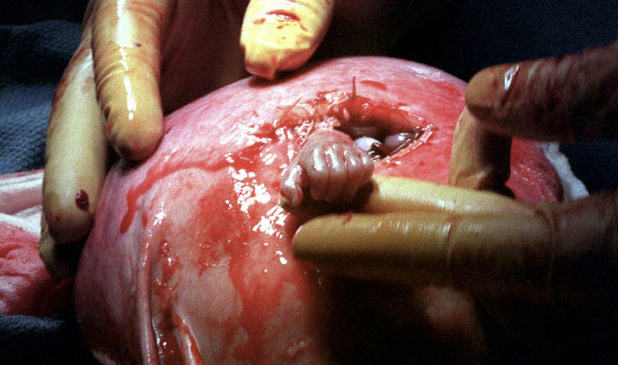In 1999, photographer Michael Clancy snapped a photo of then 21-week-old preborn Samuel Armas, who was grasping his surgeon’s hand through a hole in his mother’s uterus during a fetal surgery to correct his spina bifida. The photo, known as the “Hand of Hope,” became famous, because it confirmed the undeniable truth: the baby boy undergoing surgery was very much a human being.

“Hand of Hope” by Michael Clancy
Today, due to risk of premature birth, physicians have developed a new, safer technique for repairing spina bifida prior to a child’s birth. According to the UK Telegraph, “Dr Michael Belford, of Baylor College of Medicine, in Houston, Texas, has developed a new technique to remove the baby and womb so that spinal defect can be fixed before amniotic fluid eats away further at the gap in the spinal nerve tissue.”
The Telegraph goes on to say:
Although the womb is still attached to the mother, once outside her body doctors can drain it, light it up and operate through tiny incisions.
One of the first operations was performed last month on hairdresser Lexi Royer, 28, who was initially offered an abortion, but chose instead to take part in the experimental surgery when her baby was 24 weeks.
What’s interesting here is that, quite obviously, there are two human beings involved in this surgery: the mother, and the child inside the mother’s uterus. The baby, while inside an organ of the mother’s body (an organ which has the specific purpose of housing and nurturing a child during pregnancy), is a separate and distinct human being; the mother is not having surgery to correct the condition of spina bifida — her child is. This flies in the face of pro-abortion claims that a preborn child is not a human being until birth.
When a child is unwanted, that child is referred to as a “clump of cells,” a “parasite,” and as “tissue.” But listen to the way that even the pro-abortion New York Times presents the surgery on Mrs. Royer’s baby, a very much wanted child:
The patient, still inside his mother’s womb, came into focus on flat screens in a darkened operating room. Fingers, toes, the soles of his feet — all exquisite, all perfectly formed.
But not so his lower back. Smooth skin gave way to an opening that should not have been there, a bare oval exposing a white rim of bone and the nerves of the spinal cord.
Mrs. Royer’s baby was, according to the Times, “24 weeks and two days old, less than two pounds” at the time of surgery, and is referred to quite impersonally by the Times as “the fetus.” And yet, amazingly, the description of that “fetus” sounds remarkably human: fingers, toes, soles of his feet… bone and nerves… spinal cord. (Notice that “the fetus” has a sex, as we see from use of the pronoun “his.”) No, this child is not simply a part of his mother’s body. Nor is he a mere clump of cells.
However, it would have been totally legal to abort him. The Telegraph says that Mrs. Royer “was initially offered an abortion.” From the Times, we learn that the defect was discovered at a 13-week ultrasound: “Termination was offered as an option, and Mrs. Royer felt that doctors were pushing it. But this might be their only chance to have a child.” Doctors were pushing abortion? For a condition that the Times says is “generally not fatal”? Yes, they were — based on the decreased “quality of life” they assumed a child with spina bifida might have. Abortion, on the other hand, is fatal:
Mothers undergoing surgery for their children are given anesthesia. Their children in utero are, according to Cardinal Glennon St. Louis Fetal Care Institute, “given medications as needed for pain control and to prevent movement.” Yes, that says “for pain control.” The Times describes the surgery (emphasis added):
Dr. Belfort opened Mrs. Royer’s lower abdomen, but not her uterus. Instead, he eased the uterus out of her body and inserted the fetoscope, and then, through another slit, surgical tools. The doctors drained out the amniotic fluid and pumped in carbon dioxide to keep the uterus expanded, giving them room to work and allowing them to see better and cauterize when needed.
They gave the fetus an anesthetic injection and then, guided by images on the video screens, began to operate on him, tugging skin and membranes over the naked spinal cord and sewing them tightly shut with five stitches to seal out amniotic fluid.
Children can feel pain in the womb, and doctors know this. Recent research even shows that they may feel it as early as the first trimester.
This experimental surgery has already been successful in 28 patients. It will no doubt allow many more children with spina bifida a greater chance to be able to walk. The very existence of this medical advancement proves that these lives are human, they feel pain, and they are valuable and worthy of life.
Every human life should be treated with respect, beginning in the womb.






